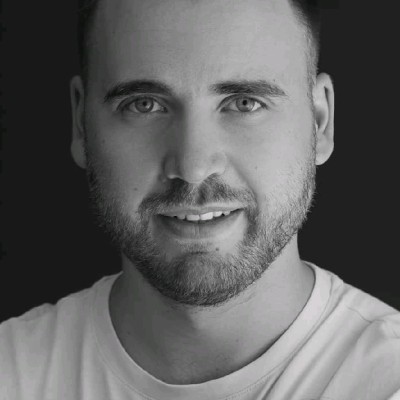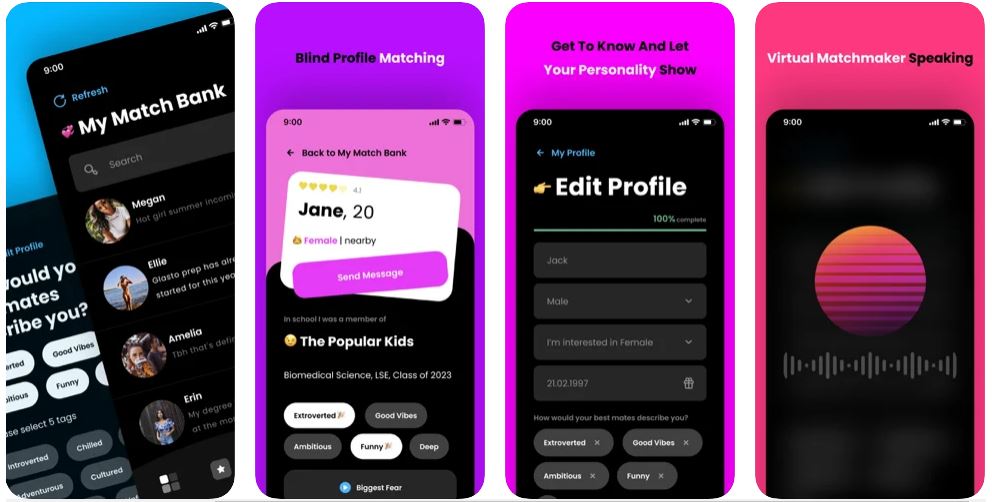Today the whole world lives online. Here we communicate, work, shop, exchange letters and information, and, of course, get to know each other. According to statistics, online dating, which eventually develops into marriages, is growing every year. The popularity of applications, sites, and dating platforms in the world is growing every day. A particularly sharp spike in users became noticeable with the start of the lockdown in the spring of 2020. Dating apps have benefited from the social distancing restrictions that have made people yearn for a company as chance encounters with friends and family have become rare.
But there is a common feature among many dating apps – their users rate each other by photographs, which makes it much more difficult for those who do not have good portraits to find a couple. This is precisely what our client Yomi Ogunyemi noticed when he discussed with his friends the dating apps they already had on their phones. Here is how the idea of a blind-dating app was born: the main goal is to show first of all the personality and rich inner world of a person and only then allow other users to judge his appearance.
About a month ago, the INCINQ application was released in the App Store. We decided to take a short interview with Yomi Ogunyemi about how the application was created and where to look for ideas for new projects.
K: Tell us about yourself. What did you do before the project creation, and what do you do now?
Y: I was a student before and now I work in accounting and finance.
K: How did you come up with the idea for the app?
Y: So… I have friends who use all of the apps on their phones, and they have a lot of problems relating and communicating with people on dating apps. I thought there should be a way to make an easier, more fun way for people to connect and meet online. That is why we decided to restrict one feature that could make the whole process more fun. Limiting the ability to view a photo at the start makes it more engaging for the people, and it’s almost like a game now.
K: What came first – the desire to help young people or the idea to create a dating solution?
Y: To help young people. Entering lockdown, people felt isolated, and especially young students who will not be having a whole university experience, so to help them connect with other students and other people, during a lockdown situation. So that’s yeah…
K: Have you researched similar apps? Have you been inspired by the work of your competitors?
Y: No. I think there are a lot of new ideas in the space, so I thought now is an excellent opportunity to try and do something different, which is maybe in a few years, those ideas would not have worked. But now it is a perfect time. We have had this app for such a long time, so people sort of know what to expect, so if you can be something slightly different than that, it makes it a lot more fun and engaging.
K: Have you tested the idea on your friends and family? What helped you decide to develop?
Y: No, the proof of concept is the app, so it is just an MVP. Anyway, it is sort of known if it would have any variable chance to create and put it into the market and see the feedback. Still, beforehand, there was no trial run or experiment, so the app itself was the experiment.

Here is how Yomi started shaping his idea and preparing for the development. The pictures were provided by him.
K: What were you afraid of when entering the market? What risks were taken into account?
Y: The main fear probably would be that people would not like the idea or would not be interested in it. So regardless of what type of idea you try out, there will always be the fear that it is not popular or does not connect to customers, and people would not understand it. So enough people not understanding the concept is probably the number one challenge, I would say.
It has been quite polarizing so half of the people really liked the idea, and then another half did not really understand it, so some people think this is a really interesting and unique idea, and some people struggle to see how it can compete with other apps in the same market. So they have been more skeptical, but generally, the majority of people think this is more like a novel interest idea.
K: What difficulties did you encounter during development? Did you manage to solve them?
Y: Problems. I think the concept is sort of understood really well, so then when it was coded there were not any significant issues, there might have been minor tweaks around the edges. Once you have seen something you might have thought this would be better, so it is more improvement that there were not any major significant issues that I came across really. It was a smooth process developing it.
K: Was it easy to work with the team?
Y: Yeah, really really easy, really great.
K: How often did you communicate with the team?
Y: I think towards the earlier stages, not so much as they were doing the requirement gathering. But once we started getting to the demos and having regular demos and walk-throughs, there were some weeks when we communicated every day. There were some weeks when it was every couple of days. They were always there when I needed it, always available if I needed someone to talk to.
K: How did you choose the team (what was decisive in the selection), and how did you find Altamira?
Y: I was looking for the best developers for people who have not developed any products before within Europe. I think people have recommended that Ukrainian agencies are the best for MVP products and have someone who wants to try an MVP idea. I thought, why not look at some of the best, and then once I reached out to Altamira. They were good at giving me a cost estimation, product requirements and making it understandable for someone who does not come from a technical background, which made it approachable for me. It was just really approachable after actually initiating contact.
K: Did you change or add something to the project during development?
Y: Yeah, there were minor changes along the way. So after seeing how some of the requirements turned out, we realized there was probably a better way to do it. Sometimes Altamira recommended a different, more optimal way to do something vs. what I initially thought. There were a few issues as well when certain things were not included in the product requirement popped up later, as later additional requirements that were not added initially. Hence, there was nothing significant, just more like the improvement that was added at the end.
K: How did the first users start coming in?
Y: The first users were our friends and family, so you tell everyone, and then everyone downloads the app. I think they want to be supportive, and then I said yes, but I think they genuinely meant it.
K: How are you promoting your project?
Y: I have done social media marketing, and I am planning to work with an influencer agency in the future.
K: How did you sponsor the development?
Y: I actually pitched an idea to an investor, an angel investor that I know through a friend of a friend and that person actually liked the idea and they were willing to invest in the product.
K: Are you satisfied with the finished project, and do you plan to develop (improve) it in the future?
Y: I am delighted with the finished product, and I already have lots of ideas for the future backlog of new ideas to try in the app. So, that new plan is already going on for future features.
K: How are things going after the release? How many users does the app have now?
Y: So, there was sort of quite a considerable uptake at first. The first bulk of people sort of friends, family, friends of friends, and are now at a phase when trying to find a product-market fit. We are trying to find the community to build rather than specifically have everyone download it because people are more likely to stay longer. If they have, if there is a sort of community filled with the people nearby, they age, instead of just having loads of numbers from all over the world, so that we have at the moment.
K: What do you remember about working with the Altamira team (positive, negative)?
Y: I think it was the second demo when I think all of the different product requirements were finally in the app. I went to download it for myself and see it and play with it. It was an extraordinary moment because it was finally real on my phone, which was probably the best part.





